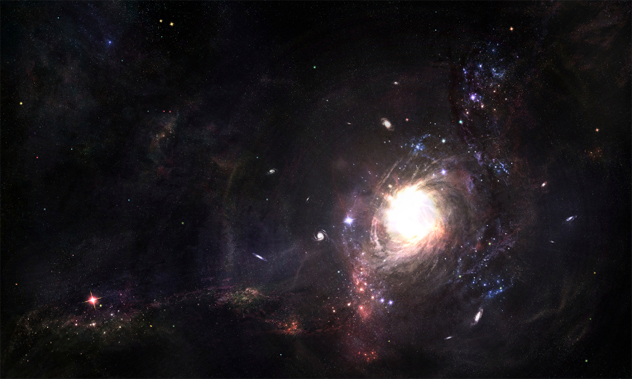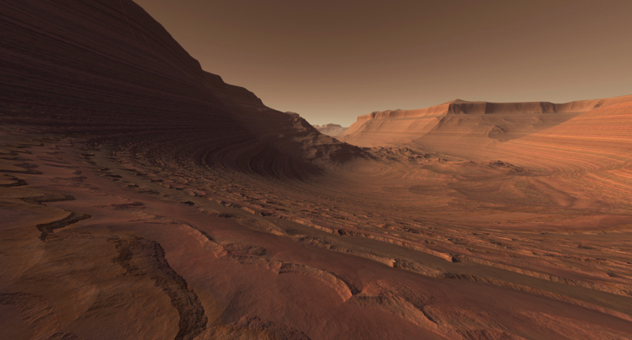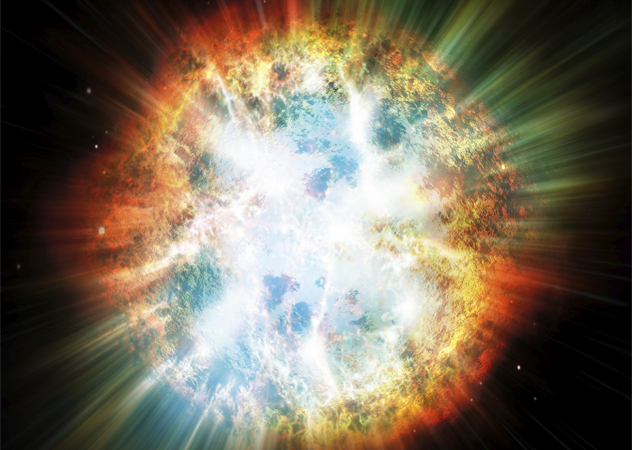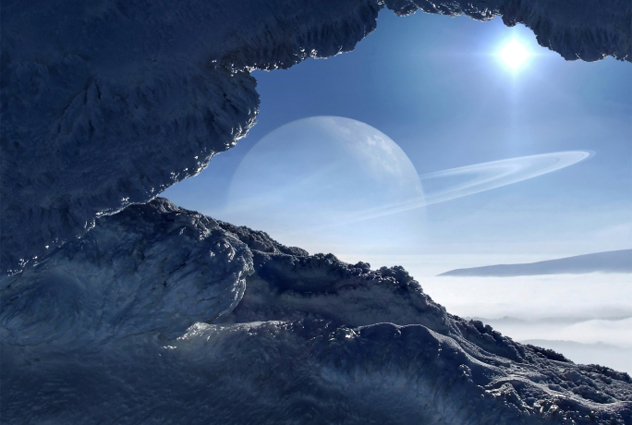5.最小的星系
Galaxies are immense—countless stars set in an image painted by nuclear processes and gravity. They're so overwhelmingly large and luminous that we can see many of them with the naked eye across great distances. So it's easy to forget that galaxies can be found at the opposite end of the size spectrum as well.
星系无边无际——那是无数的星星在核反应和重力的作用下所构成的画面。他们无限庞大,耀眼无比,以至于我们远距离就能用肉眼观察到他们。因此人们很容易忽略能够找到微小星系的可能性。

'Segue 2' is an example of how something small can take us by surprise, because it only contains about 1,000 stars. For contrast, our galaxy boasts a number in the hundreds of billions. The combined output of the whole galaxy is only about 900 times greater than our Sun, quite underwhelming considering our own star isn't especially large or impressive on a cosmic scale. As the capabilities of our telescopes improve, we might find more outliers like Segue 2, which is great for math, because galaxies of this size were predicted but never observed until recently.
Segue 2矮星系是一个 "小巧玲珑" 出其不意的典型例子。因为它只包含1000颗恒星。相反地,我们的星系却拥有数以亿计颗恒星。鉴于我们的星系在浩淼的宇宙中不是特别巨大和突出,而它整个星系的合成输出仅比我们的太阳系多出900倍,这着实让人感到失望。随着望远镜性能的不断提高,我们也许会发现更多像Segue 2一样的"局外人"。这对于数学的发展无疑是件好事,因为这样大小的星系曾被预测过,但直到最近才被观测到。
4.最大的撞击坑

Ever since we've been studying Mars in appreciable detail, there's been disagreement about what caused the planet's hemispheres to look so dissimilar to each other. A new-ish theory states that the disproportion is due to an immense catastrophic impact that changed the face of the planet. The Borealis Basin offers clues to Mars' tumultuous past, as this is the largest crater (so far) in the Solar System. It covers a large portion of the planet: at least 40 percent, spanning an area 8,500 kilometers (5,300 mi) across. The second largest crater is also on Mars, yet is four times smaller.
自从我们开始研究火星以来,到底是什么使得火星半球与其他行星大相径庭,人们对此一直存有争议。一个最新的学说阐明了此差异是因为一次巨大的灾难性的撞击改变了火星的本来面貌。伯勒里斯盆地——也是迄今为止太阳系里最大的撞击坑,为火星骚乱的过去提供了线索。它覆盖了大部分的火星:其面积就占了至少40%,跨度长达8500公里。第二大的撞击坑也在火星上,不过比伯勒里斯盆地小四倍。
To have produced such a large crater, the ancient impact must have been absolutely otherworldly, with the offending projectile calculated to have been larger than Pluto.
能够产生如此庞大的巨坑,早期的那次撞击必定是空前绝后的,据计算撞击的抛射体体积比冥王星还要大。
3.Closest Perihelion In The Solar System
3.近日点最接近太阳的小行星

While Mercury may be the closest large object to the Sun, there are plenty of smaller things that get even closer. Perihelion is the point in orbit nearest the parent star, and asteroid 2000 BD19 has the smallest orbit, getting incredibly intimate with the giant, hot ball of nuclear explosions that keeps us warm and alive. Since the perihelion is only .092 astronomical units—1 AU is about how far the Earth is from the Sun, on average—HD19 gets hot. Really hot actually, reaching temperatures that could melt zinc and other metals.
虽然水星是离太阳最近的大行星,但还有很多小行星离太阳更近。近日点是最接近母恒星的轨道上的点,而序号为2000 BD19的小行星拥有最小的轨道,与太阳无限接近。太阳是巨大的伴有核爆炸的火球,它为人类提供了温暖和生命。因为近日点只有0.092个天文单位——一个天文单位是地球跟太阳的平均距离——2000 BD19表面会变得十分炎热,其高温度足以使锌和其他金属融化。
Studying this asteroid is important because it helps us glean how different factors can shift a body's orbital orientation. One of these factors is Einstein's famous theory of general relativity. Therefore, careful scrutiny of this near-Earth object can help us see how this amazing theory relates to practical observations.
研究这个小行星非常重要,因为它能够帮助我们收集一些有关于不同因素改变一个天体的轨道定向的信息。其中一个因素就是爱因斯坦著名的相对论。因此,认真勘察接近地球的天体能够帮助我们理解这个神奇的理论如何与实际观测联系起来。
2.最古老的类星体

Some black holes are extremely massive, and that's to be expected, because they ingest anything that gets in their way.
人们预测一些黑洞非常庞大,因为他们能把任何挡道的物体全部吸入。
At two billion solar masses, ULAS J1120+0641 was a huge surprise for astronomers—not necessarily due to its magnitude, but due to its age. ULAS is the oldest quasar (basically a black hole puking into space) ever found. It appeared less than 800 million years after the Big Bang. That's absolutely ancient, and it means that the light from this distant quasar had been on a 12.9-billion-year intergalactic voyage before it arrived here on Earth. No one's sure why the black hole is so big, since there wasn't much of anything for it to eat that long ago.
ULAS J1120+0641 拥有20亿倍的太阳质量,对于天文学家来说,它的发现是个"重磅"惊喜。这不仅仅是因为它的大小,还因为它的年代。ULAS是迄今为止人们发现的最古老的类星体(基本上是由一个黑洞喷吐而出)。它在宇宙大爆炸后不到8亿年的时候形成。这绝对是非常古老的,因为这意味着来自这个遥远类星体的光要经过长达129亿年的星际之旅才能到达地球。没有人知道为什么这个黑洞如此之大,因为早前并没有很多物质能够被吞并。
1.土卫六(又称泰坦)

With spring emerging and winter clouds retreating, the Cassini probe was recently able to get some great snapshots of the lakes littering Titan's north pole topography. Water cannot exist in this alien landscape, but the temperatures are just right for liquid methane and ethane to flow and emerge from the moon's interior.
冬去春来,卡西尼号搜索太空船最近拍到了土卫六北极的地貌图,其中充满了湖泊。水无法在这个异域存在,但是温度却为液态甲烷和乙烷从月球内部涌现并且浮动创造了合适的条件。
Oddly enough, this is the first time the clouds have lifted enough to offer a clear view of the pole, even though the Cassini probe has been orbiting Titan since 2004. The main lakes are each hundreds of miles wide, with the largest, Kraken Mare, the size of "the Caspian Sea and Lake Superior combined."The existence of a liquid environment was integral for the formation of life on Earth, but seas full of hydrocarbons are a completely different animal, since material can't dissolve in this substance as well as it can in water.
说来也怪,尽管卡西尼号搜索太空船早在2004年就绕着土卫六观测,但这是第一次云层消散天文学家拍到北极的清晰画面。大部分的湖泊有数百英里宽,最大的可肯拉海是里海和苏必略湖的总和。液态环境的存在是构成地球生命的必要条件。但是充满碳氢化合物的海洋孕育的生命形式和地球不同,因为有些能在水里能分解的物质不能在碳氢化合物中分解。
















